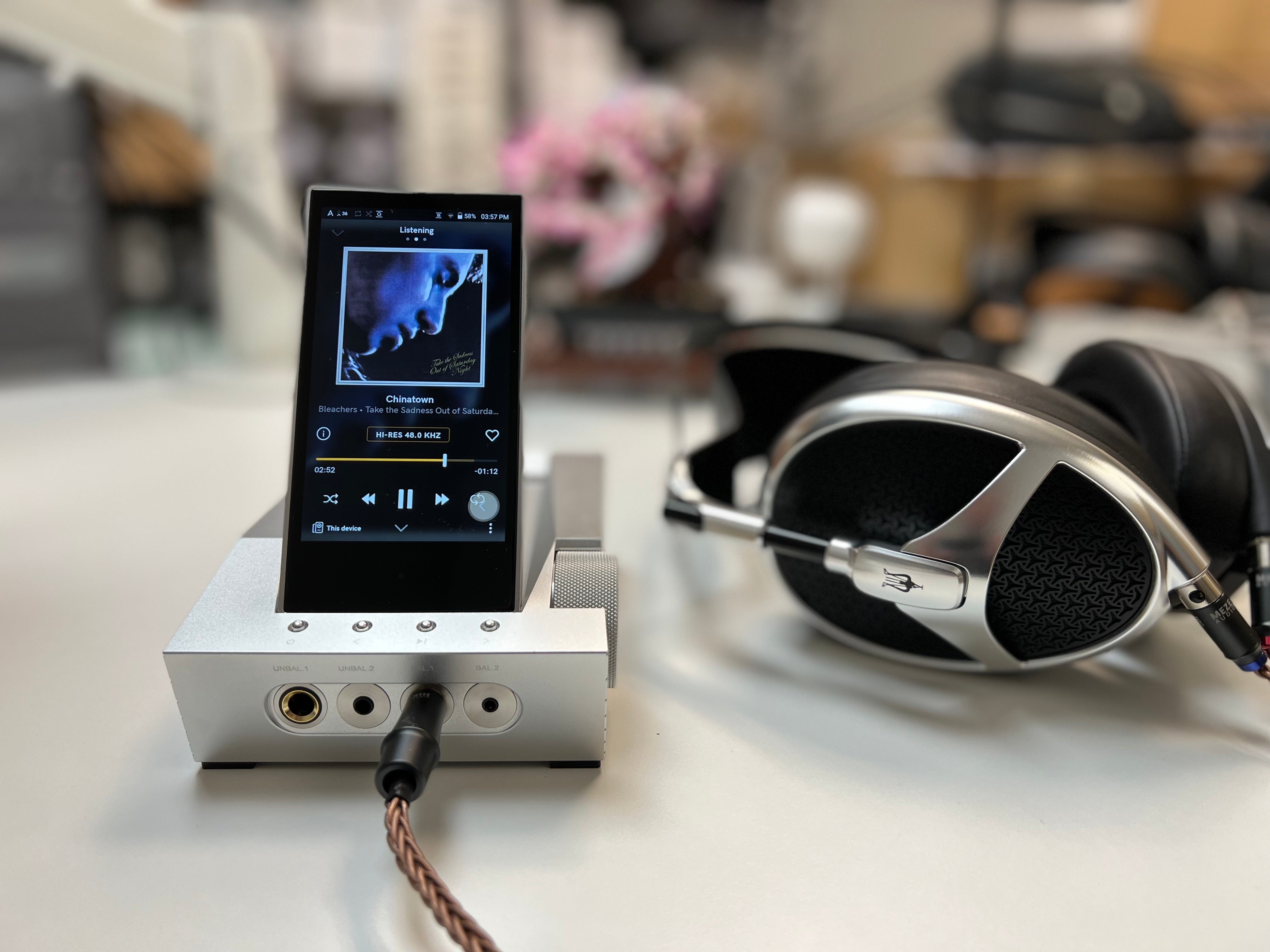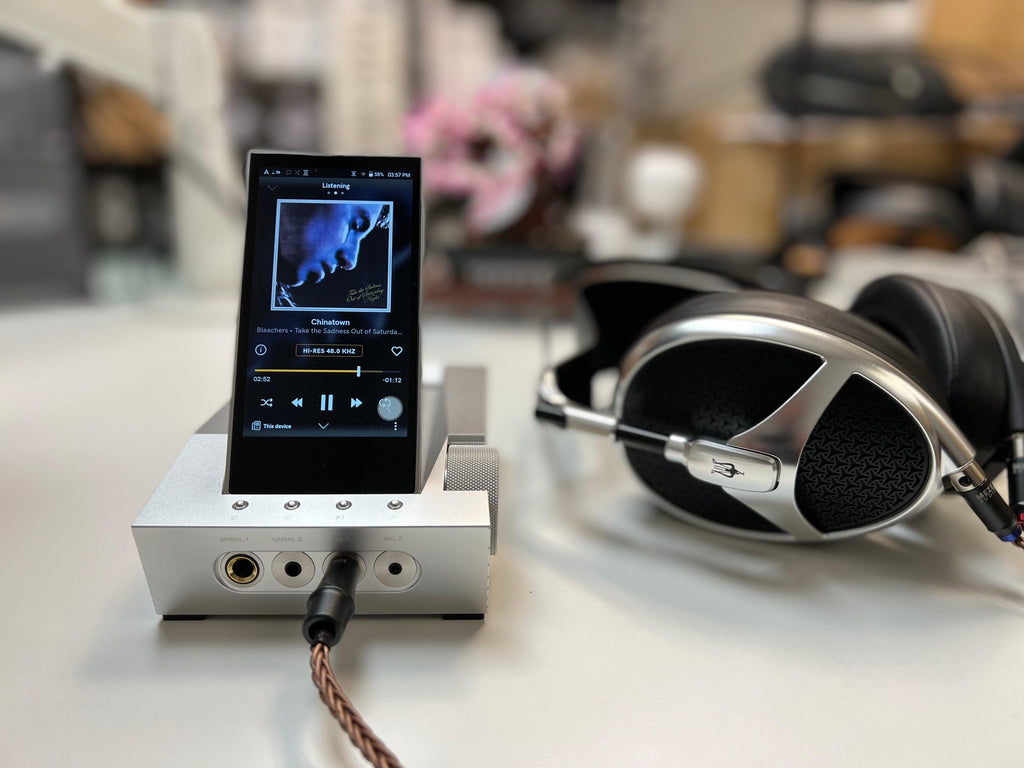While best known for their portable players, Astell&Kern has given us a variety of desktop products, from speaker amps to Bluetooth speakers, with their ACRO lineup. ACRO CA1000, the latest in that series, is a combination digital audio player, headphone amp, and DAC that rests comfortably on your desk, but is easily transportable with battery power and only requires a USB-C cable for charging. It’s all you need to enjoy your music at the highest quality, with a form form that can go almost anywhere.
Build and Design
Astell&Kern provides a simple but premium feeling unboxing experience befitting a $2199 product. What makes it work is how the cardboard and foam padding feel like they were selected for their feel and durability – not just selected for cost-effectiveness. These are the sorts of touches that enhance the presentation and feel.
ACRO CA1000’s tight, angular sculpting helps it fit in with Astell&Kern’s portable DAPs, while its size certainly stands out. The base of the unit features a selection of inputs and outputs, allowing the unit to be used as a DAC, amp, or standalone player. Of course, the real intention isn’t to use any of those features separately, but to use them all together to provide a complete, streamlined experience.
The screen can rest flat on the device, or it can be angled up to 60º for easier desktop use. It needs to be raised and lowered by pulling or pushing on the edge of the screen which can become slightly awkward as there isn’t a handle of any sort to grab the screen, nor is there any kind of lever or other device to help raise or lower it smoothly. That said, it has a very firm and stable feeling throughout the adjustment process.
The back of the device features RCA input and output, as well as USB, Optical, and Coax input. There’s also a separate USB-C port for charging, and a microSD card that supports up to 1TB of added storage. On the front, you have a general selection of outputs with 6.3mm and 3.5mm unbalanced, and 4.4mm and 2.5mm balanced headphone outputs. There are four hardware buttons on the front: power, previous track, play/pause, and next track. And the volume is controlled with a rather large wheel with a tactile click on the right side of the ACRO CA1000.
The device itself is well-built, and I pity anyone who drops it on their toe. The inputs and outputs are tight and secure, and the buttons and knobs provide good tactile feedback. The ACRO CA1000 itself is clearly a premium product, with so much attention given to the finer details.
Interface
The core device interface for the player is essentially the same as any recent Astell&Kern device. The player and collection management is front and center, and supported streaming apps can be downloaded and launched through the Services menu. Device features like Gain control (Low, Medium, High, Super), EQ, AK Connect, Crossfeed, and ReplayGain – as well as device settings and configuration – can be accessed by pulling down from the top of the screen.
The main new UI feature is the input/output control which allows you to use ACRO CA1000 as a standalone DAC or headphone amp. To access the controls, you need to pull down from the top, and tap on “Sets the input/output terminals.” Your input options from there are Optical, Digital Coax, or analog via RCA connection. You can also turn on the analog RCA output, to connect the player and DAC to an external device. This screen also lets you manage your EQ settings and Crossfeed controls. The one thing that makes this a bit odd is that ACRO CA1000 can function as a USB DAC, and you can use the headphone jacks as a line out, but this is configured through the regular settings menu, and these options are not available on the input/output control screen.
The Crossfeed and EQ both have a number of options as well as the ability to save presets. Crossfeed provides controls for a Shelf Cutoff/Gain and the Crossfeed mix level. For EQ you can use a standard graphic EQ or a parametric EQ to dial in your preferred settings and save presets.
The UI isn’t without its quirks, but Astell&Kern has continued to make improvements and add features that users have been demanding. While the touch screen performance still lags behind the competition, the available features and the quality and organization of the UI are quite good.
Sound and Performance
Astell&Kern have a tendency to deliver DAPs with a sound that’s on the edge of a reference tuning, but with a touch of euphonic smoothness. ACRO CA1000 continues this trend with an output that’s detailed and transparent, but also musical with a bit of warmth. My initial impression was that it is similar to the KANN Alpha, but with a more fully realized 3D image, broader soundstage, stronger sense of separation, and just a little sweetness in the tuning.
The overall output is impeccably balanced, with deep, natural, honest bass, good fullness through the mids, and highs which retain some extension while feeling smooth and non-fatiguing. With the right headphones, the soundstage is massive and open, presenting depth, width, and height in equal measure. The imaging and separation are strong as well, giving a holographic sense to the image, with good weight and strong positioning.
The Crossfeed feature is a new addition, and it has a surprising depth. A&K’s Crossfeed functionality allows listeners to tune not just the amount of crossfeed, but also define an EQ shelf to determine the frequencies that are fed from left to right. Playing around with this can help add even more width and depth to the soundstage, while reducing the bleed across the full frequency range to preserve imaging characteristics that can be lost in a crossfeed.
ACRO CA1000 is highly versatile, and can deliver a pitch black background for sensitive IEMs and heaps of power for hard to drive headphones. For the low power end, I tested a variety of IEMs including the Campfire Sabre, Noble Tux 5, and 64 Audio Duo. I found that Low and Medium gain worked perfectly with no hiss, with balanced providing some subtle improvements in the noise floor and performance.
While the amp can push out 15Vrms in Super mode, it’s not going to deliver the sort of power you get from the iFi Pro iCAN or the Burson Soloist’s Class-A grunt, but it is going to be sufficient for just about anything you throw at it. Along with the impressive power level, the built in EQ can also help fill in some extra slam for harder to drive planars to push the bass performance over the edge into really high performance territory.
Comparison: ZEN One Signature, ZEN CAN Signature HFM, and Astell&Kern SR25 MKII ($1397)
The ACRO CA1000 is quite the versatile device, but you can replicate the same functionality in a more modular setup, and possibly save some money in the process. To test this out we put together a stack with the ZEN One Signature for the DAC and Bluetooth receiver, ZEN CAN Signature HFM for the amp, and Astell&Kern SR25 MKII as the player. In terms of the core functionality, things were pretty well matched up, but there were some pro and cons to each setup.
In terms of the sound and performance, the ZEN Signature line provides excellent sound quality for the price, but in this case, they just didn’t have the same level of detail or quite the same balance and cohesive feeling to the tuning as the ACRO CA1000 does. While the ZEN Signature combo using the SR25 mkII as USB transport provides strong detail and a generally three dimensional feeling, the ACRO CA1000 presented a wide soundstage and stronger imaging. The power is a highlight for the ZEN combo though, as the iCAN had a leg up on the ACRO in powering harder to drive headphones.
In terms of the connectivity and feature set, with a couple modifications here or there (the ACRO’s Crossfeed vs. the ZEN XSpace), but there were some minor problems getting things together. SR25 only seemed to work consistently with the ZEN One with certain USB cables, and the cables in general made for a larger messier footprint. On the other hand, there was a bit more flexibility in terms of upgrading or swapping different pieces into the ZEN/SR25 combo. The ACRO CA1000 can, of course, function as a modular piece in a more complex setup (like plugging it into an external headphone amp), but the more you treat it as a modular piece instead of an “all-in-one” the more you take away from the elegance and simplicity of the device.
In terms of comparing it to any number of other devices, that’s really what it comes down to: how much do you value the elegance of an integrated setup over the opportunity for customization and performance tweaks? ACRO CA1000 is not going to be the best possible bang for your buck, but it is going to give you an unmatched blend of convenience, versatility, and sound quality.
The Bottom Line
ACRO CA1000 is powerful, beautiful, capable, and just a little quirky. It’s an all-in-one device that can flex into a variety of positions, whether it be a DAC, amp, USB transport, standalone DAP – 0f course, where it really shines is when it’s all of those things at the same time. If you’re looking for an integrated desktop audio solution, ACRO CA1000 should be at the top of your list.








